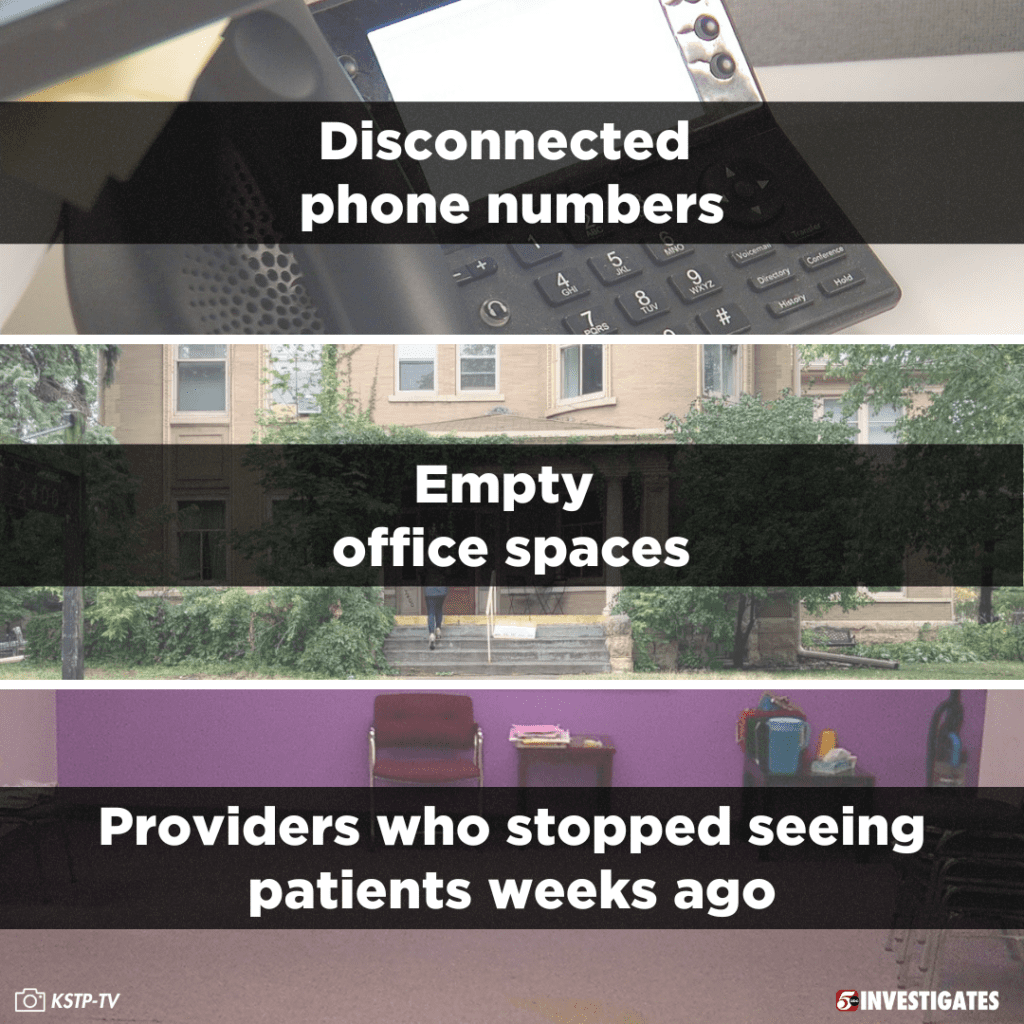Dead phone lines and empty offices: Mental health providers are closing and Minnesota doesn’t know
The door to suite 2B-5 was locked. The phone rang and rang, never hitting a voicemail message.
The office in the basement of the old Victorian home in Minneapolis was listed in state records as an open and active program for substance use disorder treatment.
But the woman who offered those services hadn’t been seen in months.
“I think she went back to London,” said a neighbor who also worked in the building.
The treatment provider is one of more than a dozen programs recently identified by 5 INVESTIGATES that are not operating despite being listed as “active” in a state database that is supposed to track care providers in real-time.
It means the Minnesota Department of Human Services (DHS) does not truly know which businesses are actually providing care, even as the state grapples with an increase in the need for mental health and substance use disorder treatment programs.

While DHS downplayed the discrepancy, providers and patient advocates say it adds uncertainty and confusion to a system already in crisis.
“If that safety net falls apart, we don’t have a backup plan,” said Jin Lee Palen, executive director of the Minnesota Association of Community Mental Health Programs.
Dead phone lines and empty offices
There are more than 440 licensed substance use disorder treatment providers that are open and serving clients across the state, according to DHS.
“There’s a lot of programs that are operating and serving Minnesotans every day,” said Eric Grumdahl, assistant commissioner with DHS.
Related: Hospital adds new wing to serve an extra 1,000 kids, teens, young adults
But in September, 5 INVESTIGATES surveyed more than 260 businesses in DHS’ database and discovered at least 15 locations that had either closed down or appeared not to be operating.
Phone numbers were disconnected.
Addresses listed on the license led to empty office spaces.
Several other providers confirmed they’d stopped seeing patients weeks ago.
That includes two programs that closed this past summer after nearly three decades of providing care.
Out of Options
Brian Sammon opened Options Family and Behavior Services 27 years ago. The day-treatment program served adolescents who struggled with severe mental health issues and substance use disorders.
The secure facilities in Burnsville and Roseville helped children who no longer needed hospital-level care but who couldn’t yet return home full-time. Participants spent three to four hours a day with licensed staff, five days a week.
“This is the group of kids that if they don’t get this are back in the hospital, are suicidal, are running the streets, all kinds of stuff,” Sammon said.
The need for intensive programs, especially for children and teens, has skyrocketed since the beginning of the pandemic. In Minnesota, healthcare providers are reporting record numbers of children with behavioral health issues being dropped off at hospitals with nowhere else to go.
Sammon prided himself and his staff on being able to fill that gap for families in need.
But the last three years took a toll on his business and its budget. The legislature increased treatment reimbursement rates for mental health programs by just 3% this year.
“The wages we pay to our staff have gone up 30% in the last two years,” Sammon said. “It’s unaffordable at this point.”
Palen, who represents dozens of mental health programs across the state, said providers are experiencing a “perfect storm” of factors.
Low reimbursement rates, coupled with a workforce crisis brought on by the pandemic, are forcing providers to make difficult decisions.
In June, Sammon announced both Options locations would close.
“It’s kind of like being at a two-week long or four-week long wake or funeral,” he said during an interview in July. “It’s always just ‘goodbye, goodbye, goodbye.'”
As of this week, those programs are still listed in the state’s database.
A ‘very small percentage’
During a nearly half-hour-long interview, Assistant Commissioner Grumdahl declined to comment on specific programs.
“We know that the programs that are not currently active in a license represents a very small number relative to the total number of programs that are operating,” he said.
Grumdahl added that service providers are not required by law to report when they shut down.
But Sammon said he did inform DHS he was closing Options permanently. It was a choice he never imagined he’d have to make.
“At some point, retirement would come up, [I’d] find another provider like myself who’d want to take it over and move it on to them,” Sammon said, getting emotional. “It was never to close it up.”
And according to the state database, he never did.